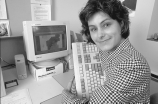|
Picture this: a history professor plays one of Winston Churchill's famous
speeches off the Internet.
Or, that letter written in 1866 to Sir John A. MacDonald, kept in Ottawa's
National Archives, is quickly downloaded and projected on the large screen
in front of absorbed students.
A physics teacher shows students the seismic graphs from an earthquake as
is it happening across the world.
And the next time the "Canadarm" is used in space, the satellite downlink
shows students what NASA is up to.
All this and much, much more is literally at your fingertips in the Henry
Marshall Tory Lecture Theatres, also known affectionately as the "Tory
Turtle."
After $1.5 million in renovations and upgrades over the summer, the
"Turtle" is now a prototype "smart classroom" cluster. Funded jointly by
the provincial government's Infrastructure Renewal Envelope and the
University, the complex now contains new sound systems, network and
satellite connections, video and data projection and more.
Instructors are not limited to the central control podium, which rivals any
commando deck Star Trek's Capt. Jean-Luc Picard is used to.
The equipment can also be operated by remote control, allowing instructors
to walk around during lectures.
If something freezes, or breaks downs, technicians at a centrally monitored
diagnostic support system can immediately and remotely pinpoint and fix the
problem.
"The potential is almost infinite ... almost limited by the imagination.
And I guess that's what we're trying to fire," says Judith Ross,
director of technical resources and chair of the Tory classroom enhancement
committee.
Ross says the "Turtle" was an obvious choice to upgrade and renovate first
because "we wanted to have an impact, to have a significant benefit to the
greatest number of students in the greatest number of disciplines."
That's why seating, lighting and ventilation were also improved in the
complex, which was built in the mid-1960s and hadn't been touched since.
But the small, plastic and highly uncomfortable chairs were not the only
things ripped out of the "Turtle."
The blackboards are gone.
So is the chalk.
Chalk dust is detrimental to the equipment's longevity.
Instead, instructors have the use of high-quality overhead projectors for
writing.
During a "Tory Turtle" preview, many professors expressed excitement about
how they could use the facilities for their lectures.
Some professors, however, are concerned about losing one of the most simple
but effective tools for teaching.
One U of A professor, who did not wish to be named, says his idea of
high-tech is using colored chalk.
"The Tory Turtle is a great showcase, and it's great for public affairs,"
he said, "It shows government the U of A is moving into the twentieth
century ... [But] downloading pictures off the Internet won't teach
students where the photos came from.
I would love to be able to use those tools.
But if I'm in a classroom that doesn't have a blackboard, or whiteboard,
then I can't teach."
Resistance to technological change is nothing new, says John Paterson,
associate dean of the faculty of education.
"When I was teaching, people said the same things about the film strip.
At the university level, we have people who will be going out to the
real world."
That means the University must teach with the latest technology and make
sure students are familiar with it, says Paterson.
After all, "nobody writes textbooks with typewriters anymore."
Can we expect the U of A to "smarten" all classrooms on campus?
"Ideally, someday. But that's quite far in the future," says Ernie Ingles,
associate vice-president (learning support systems).
"Not every classroom on campus needs to be equipped like the 'Turtle.'
But there will be varying levels of 'intelligence.'"
Henry Marshall Tory Lecture Theatres Contain:
|
 Joanne Martel
attended the "Tory Turtle" preview August 13 and took plenty
of notes.
The criminology professor says she couldn't wait to rush back to her office
and try to book her lecture in one of the theatres.
Joanne Martel
attended the "Tory Turtle" preview August 13 and took plenty
of notes.
The criminology professor says she couldn't wait to rush back to her office
and try to book her lecture in one of the theatres.
Her eyes widen with excitement as she describes what she can do with the
new features.
"I have old pictures of prisons which I'd like to show my students.
Now, I can place the photos, or textbooks, on the document visualizer
and I get a clean picture up on the screen for the students to see.
I can download pictures from archives or video through the Internet
and show it in class.
Students learn better by seeing and hearing.
Because of all this technology, we can combine both and it will increase
the capacity of students to learn.
They're going to love coming to class!"
Are educators too concerned with entertaining students?
"This is the popular culture of students.
They're used to learning through these technologies.
A professor must remember he or she is performing in front of an
audience to communicate knowledge."
 Josef Takats
is a self-described "classical lecturer."
The chemistry professor quite likes using a blackboard.
"It give me a sense of action.
I can do a better job of transmitting excitement to the students
on a blackboard.
New technology is certainly a supplement but it should not be a replacement.
If I start bringing all my notes prepared for an overhead, it takes away
the spontaneity.
It's not the same as solving a problem in front of students.
Sometimes we make mistakes on blackboards, and I don't think this is bad
for students to see, to see we are human.
It is easy to have easy access to information with new technology.
But it's important for the students to realize that this is not the same
as knowing the material."
Josef Takats
is a self-described "classical lecturer."
The chemistry professor quite likes using a blackboard.
"It give me a sense of action.
I can do a better job of transmitting excitement to the students
on a blackboard.
New technology is certainly a supplement but it should not be a replacement.
If I start bringing all my notes prepared for an overhead, it takes away
the spontaneity.
It's not the same as solving a problem in front of students.
Sometimes we make mistakes on blackboards, and I don't think this is bad
for students to see, to see we are human.
It is easy to have easy access to information with new technology.
But it's important for the students to realize that this is not the same
as knowing the material."
|


![[Folio]](http://www.ualberta.ca/~publicas/folio/gif/small/folio.gif)
![[Office of Public Affairs]](http://www.ualberta.ca/~publicas/gif/small/opahome.gif)
![[University of Alberta]](http://www.ualberta.ca/~publicas/gif/small/uahome.gif)